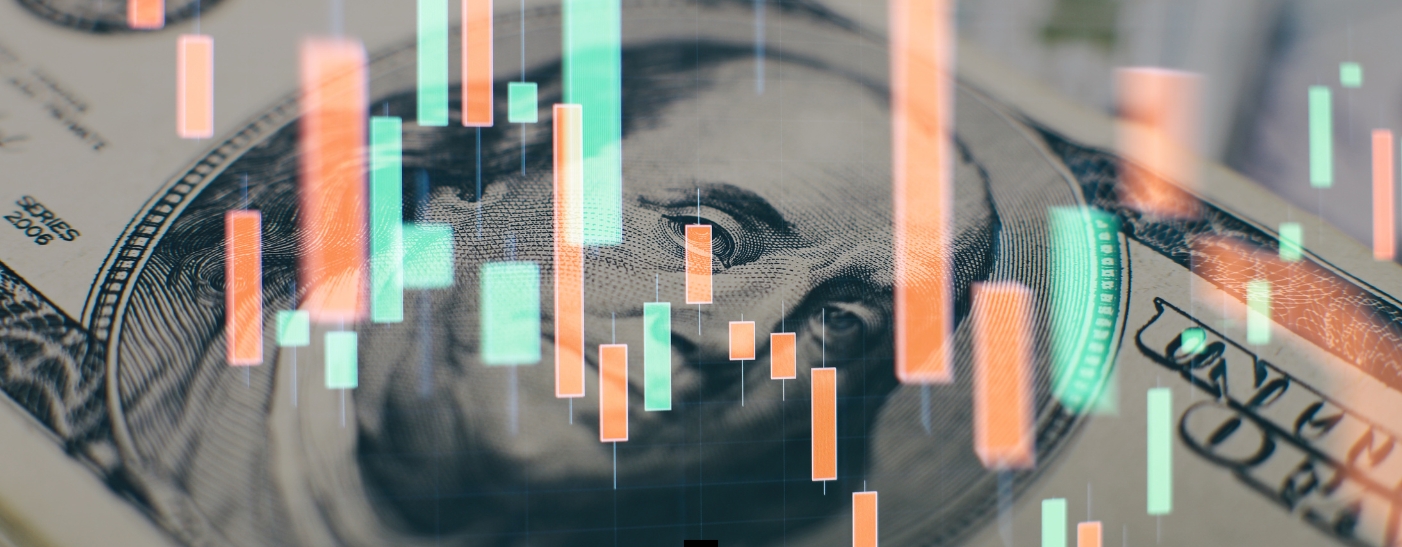
Buy Dividend Growth Stocks as Fed Cuts Interest Rates
Let’s discuss the huge money-elephant in the room.
Millions of investors hiding in money market funds are about to see their income fall in a big way.
With the Fed finally cutting rates, yield hungry investors will have to work harder to generate income.
Today, we’ll show you why now’s the time to buy dividend growth stocks as the Fed cuts interest rates. Then we’ll show you how to maximize the theme with timely ETFs and sectors.
And the income rotation is already underway.
Money in Motion
There’s a record $6.3 trillion crowding in money market funds amid the lure of 5% risk-free returns (chart).
But the Fed funds futures market predicts money market yields will fall to just 3% by the end of 2025.
Bond funds aren’t the answer. While bonds generate big capital gains as yields fall, that’s already happened. Yields on short, medium and long-term bond funds are all down big in anticipation of Fed easing.
By contrast, dividend strategies still have plenty of upside. It’s no surprise dividend paying S&P 500 stocks are up 14.5% vs. only 8.1% for non-payers YTD.
Since the great rotation that began on 7/11/24, dividend-yielding S&P stocks are up 8.4% vs just 5.2% for non-payers. Even more striking is the fact that stocks with a 3% yield or higher have gained 10.9% in the same period.
The pivot to dividend stocks is money in motion. It’s only a matter of time before the crowd recognizes that money-market rates are a sinking ship:
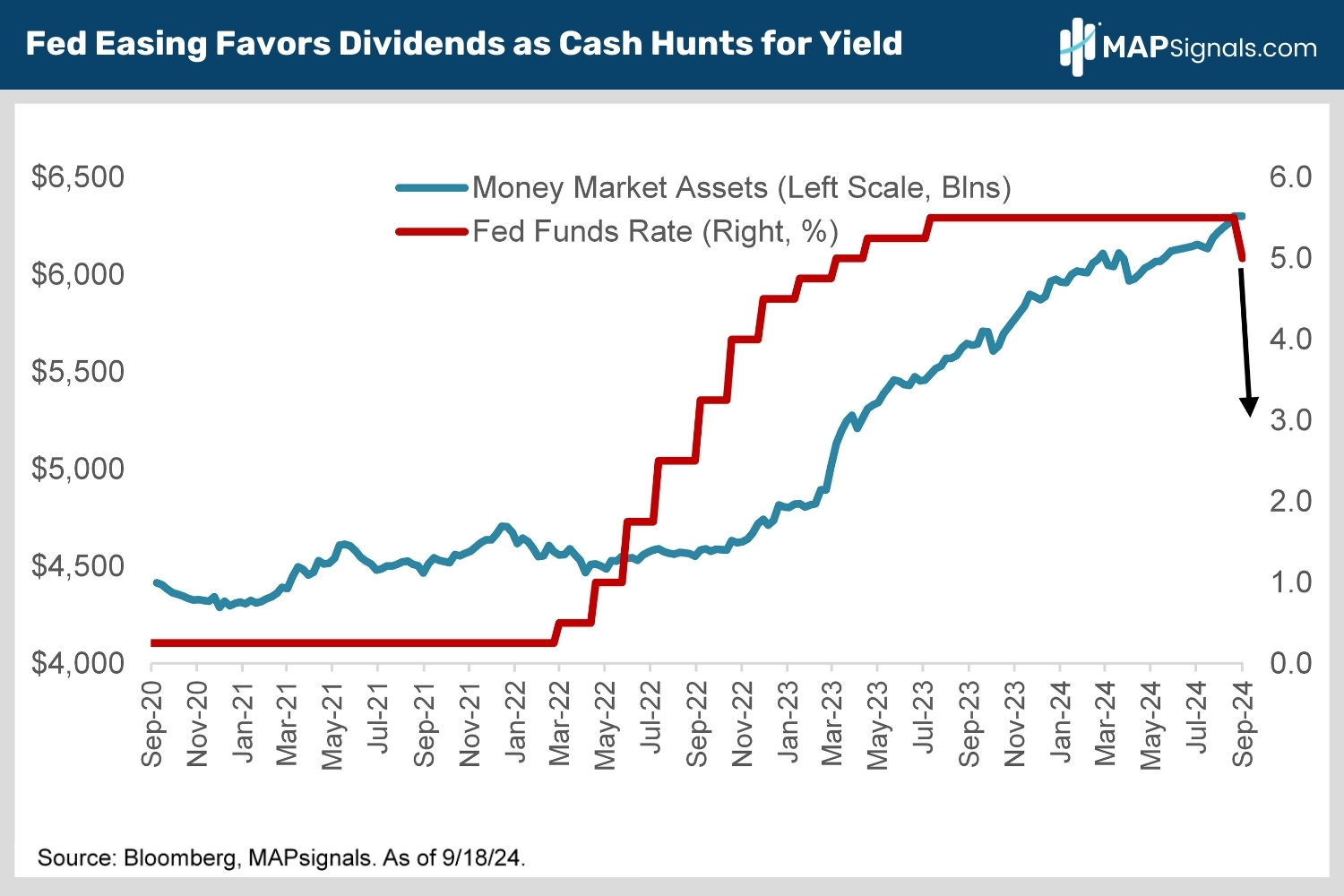
Once large income shortfalls hit money market investors…they’ll be hunting for an income-generating alternative.
Buy Dividend Growth Stocks as Fed Launches Rate Cuts
Albert Einstein once described compound interest as the “eighth wonder of the world.” He was 100% right.
How else could low single digit stock dividends account for a stunning 37% of the market’s long-term returns (chart)?
Since 1930, the S&P 500 has returned only 6.6% a year excluding dividends vs. 9.8% with those payouts reinvested.
Below you can see how reinvesting growing dividend payouts has helped equity returns over time:

Let’s face it, dividends make a huge difference!
Dividend growth explains the outsized impact of equity income on long-term stock performance.
The ability of high-quality companies to reliably grow their payouts year-in and year-out takes the “compounding” effect Einstein referenced to the next level.
You’re not reinvesting the same amount every year. The annual growth of your reinvested payouts supercharges long-term compounding.
Since 2000, S&P 500 dividends have more than quadrupled from $139B to $588B in 2023 (chart).
That equates to 6.8% annual income growth. It doesn’t take much annual growth to generate huge long-term gains.
Better yet, despite record payouts, the S&P’s payout ratio – the percentage of profits its constituents use to cover dividends – is still only 35%, well below its 50% long-run average. That leaves lots of room for future dividend appreciation!
Huge income growth is welcome news any day, but it’s especially valuable with the Fed cutting interest rates and bond yields melting lower!
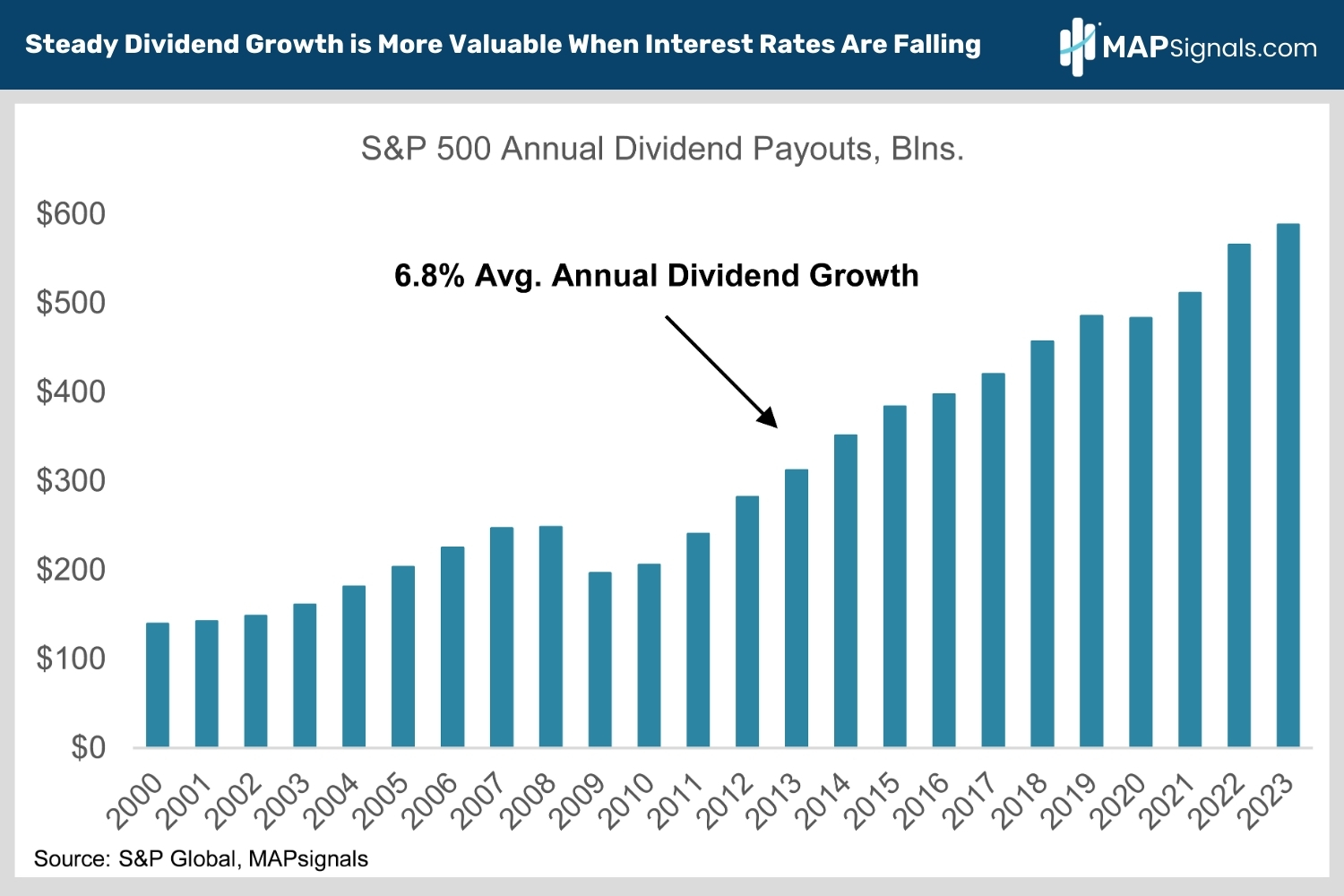
Let’s shift gears. Growing dividends in a falling rate environment isn’t the only reason to like dividend growth stocks.
Volatility hasn’t been a huge problem this year. Stocks are doing great as the rally broadens out. Even with all the recession and election handwringing, market drawdowns have been short and sweet.
But investor surveys consistently show market volatility as the #1 reason they shy away from stocks.
Here too, dividends can help. Check out this next chart.
Since 1990, companies with the financial strength to grow their dividends outperformed during volatile markets.
The VIX is the leading gauge for measuring S&P 500 volatility.
In all months when the VIX Index increased, dividend growers beat non-dividend paying stocks by an average of 1.06%.
Even better, the more volatility rises, the more dividend growth stocks outperform.
In months when the VIX rose over 20%, dividend payers outperformed by 2.06%.
Holding dividend growth stocks can enhance performance whenever volatility rears its ugly head:
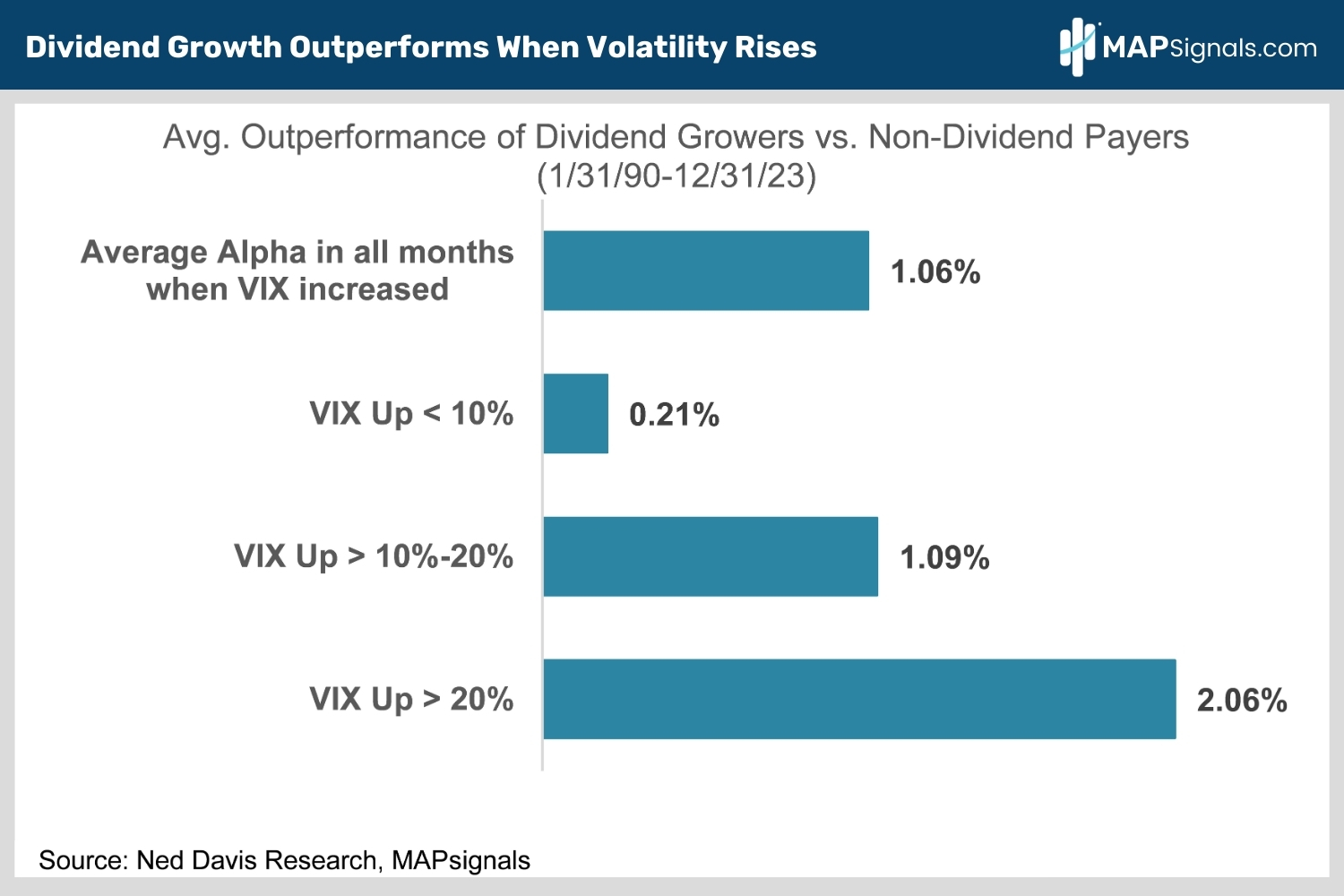
What this Means for Your Portfolio
We’ve made the macro case for dividend growth stocks. Now, let’s tackle portfolio construction.
We know big yields are tempting, but oftentimes, a high dividend yield signals distress. The payout may be high because the company’s shares have either fallen due to poor fundamentals, or it’s the only way to entice investors to buy the stock, or both. Think CVS (CVS), Walgreens (WBA) or AT&T (T), ouch!!
Either way, it’s a head fake and that juicy yield is often wiped out by a few months of capital losses.
It’s no surprise dividend growth strategies consistently outperform their high dividend yield counterparts (chart).
The bottom line is quality matters. Dividend growth stocks have a return on equity of 27% vs. only 17% for high dividend stocks. It’s impossible to consistently grow your dividend without impressive financial strength. Over time, that beats high, but iffy, yields.

Vanguard’s $100B Dividend Appreciation ETF, VIG, tracks S&P’s Dividend Growers Index which requires 10 years of dividend growth for inclusion. VIG yields 1.9% and sports a rock-bottom 0.06% expense ratio.
VIG’s 64 MAP Signals’ map score shows accelerating institutional buying without being anywhere near overbought (think 80+).
By contrast, our ETF rank for the smaller, $72B Vanguard High Dividend Yield ETF, VYM, also a category leader, is only 61.
VIG’s more cyclical sector allocation is yet another reason to favor dividend growth over high yields (chart).
Regular readers know we’re bullish on stocks because we believe a soft landing is in the cards.
Cyclical sectors have been held back by relentless recession worries. As the economy continues to hold up, expect cyclicals to reassert their leadership.
As for defensives, if the economy dodges recession and the Fed isn’t forced to cut rates far more than currently expected, expect these rate sensitive sectors to fade fast as interest rate declines slow.
Dividend growth is better positioned for an economic soft landing thanks to its greater exposure to the growthy tech and health care (think biotech & medical devices) sectors, coupled with lower allocations to defensive utilities and the sickly energy patch.
Note that, over the last decade, energy is the worst performing S&P 500 sector with only a 3.3% annualized return. Utilities have also underperformed the S&P 500’s 12.9% gain, chalking up just 9.1% annualized gains.
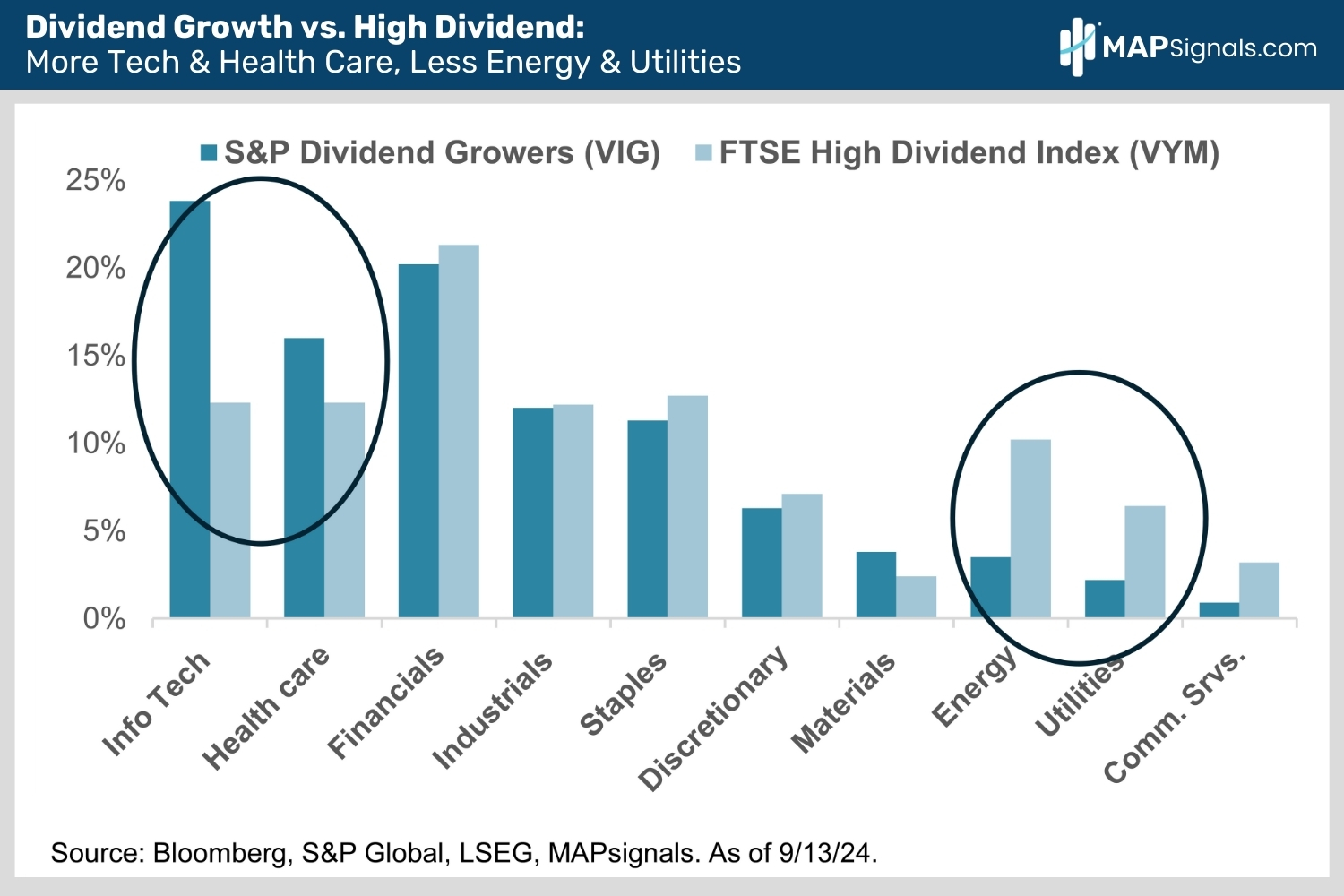
Make sure to get access to our Top 32 list of dividend-growth stocks for 2025 only for MAP PRO members. Subscribe and be prepared for what we believe is a big portfolio reweighting towards dividend-rich companies next year.
Let’s wrap up.
Bringing It All Together
Fed rate cuts are bullish for dividend growth stocks as money market yields finally start falling. Meanwhile, bond yields have already collapsed in anticipation of Fed easing, reducing bond funds’ income appeal.
Plus, dividend growth not only cushions stocks when volatility rises, reinvested dividends contribute a surprisingly high 37% of the stock market’s long-term gains.
The dividend “sweet spot” isn’t risky, sky-high yields. It’s high-quality stocks with 1.5%-3.5% yields and strong track records of doubling their payouts at least every decade.
Many such dividend growers live in the S&P 500, whose dividends have more than quadrupled from 2000 through 2023. Healthy corporate balance sheets and low payout ratios mean more dividend hikes loom.
If the economy dodges recession as we expect, and the Fed isn’t forced to cut rates far more than currently anticipated, expect the huge rip in defensive sectors to fade fast as interest rate declines slow.
Dividend growth is better positioned for a soft landing than defensive leaning, high yield dividend strategies.
It has a much larger 40% combined weight in the growthy tech and health care sectors, coupled with far lower allocations to counter-cyclical utilities and the sickly energy patch.
VIG brings it all together, offering a convenient, low-cost way to target this timely theme. And our ranking process agrees!
So just sit back and let compounding do the rest. And remember, dividend growth is the best cure for falling rates and any future market volatility.
Lastly, there are great stocks positioned well for this money in motion theme. If you want our latest star-studded list of 32 companies loved my institutions, get started with a MAP PRO subscription today.
Invest well,
Alec
